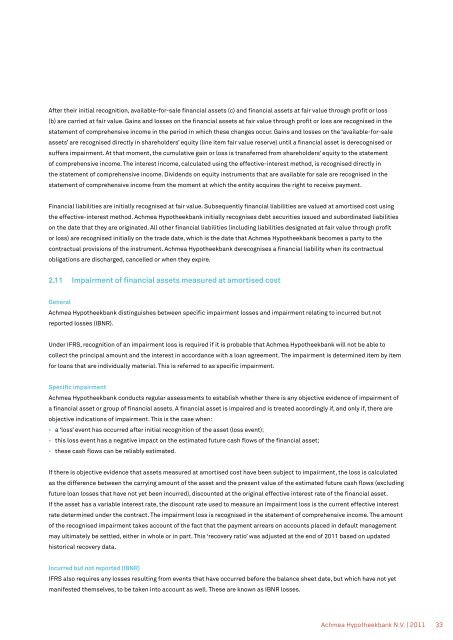Achmea Hypotheekbank N.V. annual report 2011
Achmea Hypotheekbank N.V. annual report 2011
Achmea Hypotheekbank N.V. annual report 2011
Create successful ePaper yourself
Turn your PDF publications into a flip-book with our unique Google optimized e-Paper software.
After their initial recognition, available-for-sale financial assets (c) and financial assets at fair value through profit or loss<br />
(b) are carried at fair value. Gains and losses on the financial assets at fair value through profit or loss are recognised in the<br />
statement of comprehensive income in the period in which these changes occur. Gains and losses on the ‘available-for-sale<br />
assets’ are recognised directly in shareholders’ equity (line item fair value reserve) until a financial asset is derecognised or<br />
suffers impairment. At that moment, the cumulative gain or loss is transferred from shareholders’ equity to the statement<br />
of comprehensive income. The interest income, calculated using the effective-interest method, is recognised directly in<br />
the statement of comprehensive income. Dividends on equity instruments that are available for sale are recognised in the<br />
statement of comprehensive income from the moment at which the entity acquires the right to receive payment.<br />
Financial liabilities are initially recognised at fair value. Subsequently financial liabilities are valued at amortised cost using<br />
the effective-interest method. <strong>Achmea</strong> <strong>Hypotheekbank</strong> initially recognises debt securities issued and subordinated liabilities<br />
on the date that they are originated. All other financial liabilities (including liabilities designated at fair value through profit<br />
or loss) are recognised initially on the trade date, which is the date that <strong>Achmea</strong> <strong>Hypotheekbank</strong> becomes a party to the<br />
contractual provisions of the instrument. <strong>Achmea</strong> <strong>Hypotheekbank</strong> derecognises a financial liability when its contractual<br />
obligations are discharged, cancelled or when they expire.<br />
2.11 Impairment of financial assets measured at amortised cost<br />
General<br />
<strong>Achmea</strong> <strong>Hypotheekbank</strong> distinguishes between specific impairment losses and impairment relating to incurred but not<br />
<strong>report</strong>ed losses (IBNR).<br />
Under IFRS, recognition of an impairment loss is required if it is probable that <strong>Achmea</strong> <strong>Hypotheekbank</strong> will not be able to<br />
collect the principal amount and the interest in accordance with a loan agreement. The impairment is determined item by item<br />
for loans that are individually material. This is referred to as specific impairment.<br />
Specific impairment<br />
<strong>Achmea</strong> <strong>Hypotheekbank</strong> conducts regular assessments to establish whether there is any objective evidence of impairment of<br />
a financial asset or group of financial assets. A financial asset is impaired and is treated accordingly if, and only if, there are<br />
objective indications of impairment. This is the case when:<br />
• a ‘loss’ event has occurred after initial recognition of the asset (loss event);<br />
• this loss event has a negative impact on the estimated future cash flows of the financial asset;<br />
• these cash flows can be reliably estimated.<br />
If there is objective evidence that assets measured at amortised cost have been subject to impairment, the loss is calculated<br />
as the difference between the carrying amount of the asset and the present value of the estimated future cash flows (excluding<br />
future loan losses that have not yet been incurred), discounted at the original effective interest rate of the financial asset.<br />
If the asset has a variable interest rate, the discount rate used to measure an impairment loss is the current effective interest<br />
rate determined under the contract. The impairment loss is recognised in the statement of comprehensive income. The amount<br />
of the recognised impairment takes account of the fact that the payment arrears on accounts placed in default management<br />
may ultimately be settled, either in whole or in part. This ‘recovery ratio’ was adjusted at the end of <strong>2011</strong> based on updated<br />
historical recovery data.<br />
Incurred but not <strong>report</strong>ed (IBNR)<br />
IFRS also requires any losses resulting from events that have occurred before the balance sheet date, but which have not yet<br />
manifested themselves, to be taken into account as well. These are known as IBNR losses.<br />
<strong>Achmea</strong> <strong>Hypotheekbank</strong> N.V. | <strong>2011</strong><br />
33
















